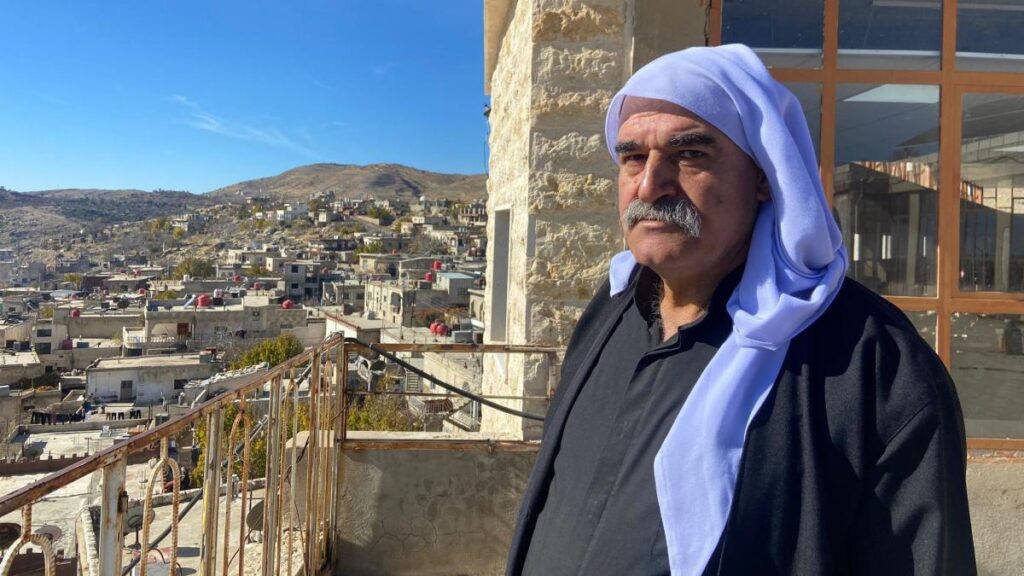An hour’s drive from Damascus, the Syrian village of Hadar finds itself at a crossroads of geopolitics and local realities. As we approach the village, we encounter an unexpected presence: Israeli military vehicles and soldiers stationed at an impromptu checkpoint. This military incursion highlights Israel’s assertion of control over the UN-monitored buffer zone, established as part of a ceasefire agreement decades ago. The villagers, witnessing Israeli forces regularly moving through their territory, hold a mixture of hope and uncertainty about the future of their home. Riyad Zaidan, a local resident, expresses a sense of fatalism tempered by hope, as the village grapples with the complexities of Israeli presence in the region.
Village chief Jawdat al-Tawil reflects on Hadar’s resilience during the Syrian civil war, showcasing portraits of local heroes who defended their land against various militia groups. Despite the community’s proud history of resistance, al-Tawil acknowledges the limitations of standing up to a superpower like Israel. The reality that accompanies the newfound sense of freedom in Syria post-Assad’s regime is overshadowed by the strengthened Israeli military actions, which have ramped up significantly following Assad’s fall. An announcement by Israeli Prime Minister Benjamin Netanyahu aims to double the population of Israeli settlements in the occupied Golan Heights—a move perceived as a response to new threats arising in Syria.
In this dramatically altered political landscape, the remarks from Ahmed al-Sharaa, Syria’s interim leader who emerged after Assad’s fall, signal a cautious stance towards Israeli military maneuvers. He warns that such actions may escalate tensions in the region, emphasizing Syria’s desire to avoid conflicts with Israel. The Israeli government, however, continues to characterize its military operations as necessary maneuvers against perceived threats from jihadist groups operating near the ceasefire line. The situation remains tenuous, with residents aware of the delicate balance they must navigate between local loyalties and larger geopolitical forces at play.
The demographic fabric of Hadar is largely composed of the Druze community, historically distinct from mainstream Shia Islam. In the wake of Israel’s occupation and annexation of the Golan Heights, some Druze chose to remain and integrate into Israeli society. Meanwhile, tensions linger regarding Israel’s ongoing military campaigns against Iran-backed militias that proliferated under Assad’s rule. The power dynamics in the region have shifted with Assad’s decline, and Israel appears to be seizing the opportunity to extend its military reach, targeting remnants of his military apparatus that might pose future threats.
Israel’s Defense Minister, Israel Katz, acknowledges that even with the apparent moderate outlook of emerging rebel leaders, risks to Israel persist. This complex ground reality further complicates the local Druze community’s interactions with the numerous militias that once represented their oppressors during the Assad era. Al-Tawil’s sentiments echo that of many in Hadar—desiring peace and resolution after years of conflict and hardship. The persistent violence has left the community yearning for stability above anything else.
As the political theater in Syria reshapes under the influence of new powers like Hayat Tahrir al-Sham (HTS), which has shifted from an alignment with jihadist groups like al-Qaeda to a more nationalistic narrative, the people of Hadar remain skeptical yet hopeful for changes in governance. The specter of past violence—and al-Tawil’s own painful loss in battle against HTS forces—underscores the fragility of this newfound order. While residents like Riyad Zaidan call for an end to the cycle of violence, lingering doubts about the intentions of newly empowered factions persist. In moments like these, the impact of history, memory, and the quest for genuine reconciliation take center stage as the villagers of Hadar confront an uncertain future amidst ongoing military maneuvering and shifting allegiances.

